Page
1 2 3 4 5 6
Note: This trip journal was prepared in 2006 using original notes from the 1960 trip, only recently discovered. Because of the deterioration of most of the color slides we took, more recent pictures have been used for many scenes. The commentary is taken from the 1960 notes and sometimes differs from what we would say today, based on broader experience.]
Introduction. An Army Captain, I had been stationed in Verona, Italy, for nearly a year. This was our first
tour in Europe and, with four small sons to look after, we still hadn’t seen much
outside of Verona and Venice. Our only overnight trip so far had been in June 1960
when we’d left the boys with our live-in maid for the first time and driven up to Oberammergau, Germany, to see the famous Passion Play. Now we had signed on for our very
first commercial tour, a five-day bus trip to Vienna, Austria, offered at a cost of $47 a person, including hotels, several excursions, and all meals but one.
Thursday, 1 September. We arrived at the
Caserma Passalacqua bus stop a few minutes before the scheduled 06:30 departure, but the bus didn’t leave until around 07:00. Even then, our first stop was the home of Alice Jenkins, our "experienced English-speaking tour conductor", who forgot her passport. (To make the detour worthwhile, she also picked up a fifth of bourbon.) We were an hour late getting to Vicenza, where we picked up more passengers. We lost another half hour there, leaving around 09:00 (instead of the scheduled 07:30). naturally, we were behind schedule all the rest of the way.
The bus was very small. There were twenty-three adult passengers (plus two little girls), but only twenty-two seats. Alice used the “jump seat” that opened between the front row seats. Part of the time we played bridge with Alice and her friend Joyce. The steering wheel of the bus was on the right (English-style), so the driver had to pull almost all the way into the oncoming lane before he could see if there was a vehicle there. The screams of those in the left front seats gave him a little advance warning, but it was an exciting ride. We took turns buying wine at each stop and passed it around, spreading germs along with good cheer. Captain Schultz (USN) initiated an "anchor pool" as to our arrival at the hotel in Graz.
We stopped in Tolmezzo for lunch, and crossed into Austria at Tarviso. It was already dark by the time we got to Graz. Alice not only didn't have the faintest idea where the hotel was but couldn't speak a word of German. Fortunately, there was a retired Air Force major (Milos Hvalek) who had been born in Vienna, and he was able to ask directions. From the bus we saw the high clock tower on the Schlossburg (castle) above the city. This is the symbol of Graz. It was floodlighted and quite impressive. We were so tired, though, that we went to bed right after dinner at the hotel.
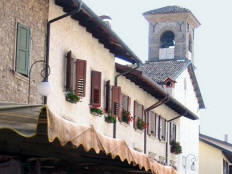
Lunch stop in Tolmezzo | 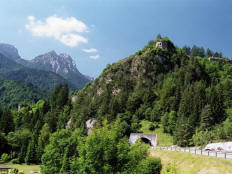
Near Tarviso & Italian-Austrian border | 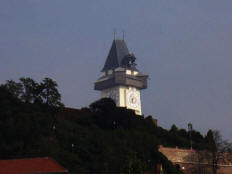
Schlossburg clock tower in Graz |
Friday, 2 September. We started the day with a "short city sightseeing of Graz" with a local guide. Graz is the second largest city in Austria, and its "Old Town" is one of Central Europe's best preserved city centers. The hill where the Schlossburg (16th century) stands has been fortified at least since Roman times but, except for the clock and nearby bell tower, the fortress was demolished by Napoleon in 1815. Surprisingly, other than a brief drive by, we didn't spend any time in either the Old Town or at the Schlossburg.
In fact, our tour turned out to be a long ride with few sights. The local guide was a professor who claimed to speak twenty-some languages fluently. However, he didn't seem to know his way around Graz any better than we did and, as we passed interesting building like the Rathaus [City Hall](1890s) and Landhaus [State Capital] (1557), he was too busy talking about himself to tell us much about them.
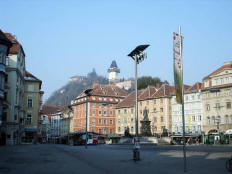
Main Square & Schlossberg | 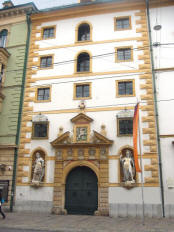
Landhaus | 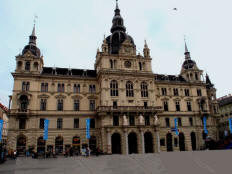
Rathaus |
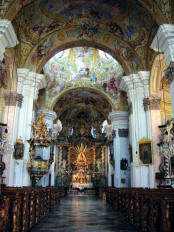
Interior of the Basilica |
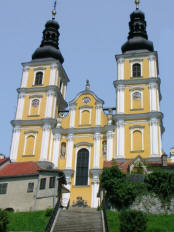
Mariatrost Basilica |
The professor did manage get us to the baroque Mariatrost Basilica (1714), a pilgrimage church on a hill on one side the city. Although it was not particularly impressive on the outside, it had a very ornate interior. It was here that we really began to doubt the guide's veracity because he gave three widely varying figures as to the number of parishioners.
He then tried to lead us to a hill with a panoramic view of the city, but we never did find it and wound up on a couple of dead-end roads. We finally convinced him we wanted to get on to Vienna, and he led us to a point on the highway that, by sheer coincidence, was very close to his residence. He pointed out his residence as a huge castle on a hill and claimed he, a bachelor living alone, rented twenty-some rooms there for a few dollars a month. Challenging his story, we suggested that we all stop there for coffee, but he begged off, explaining that it took a couple of hours just to walk up the stairs. We finally dropped him off and continued on to Vienna, arriving an hour or more late, making our guess in the anchor pool way off.
Page 1 2 3 4 5 6
Home
Copyright © 2000-2023 DarrellPeck.com All rights
reserved.